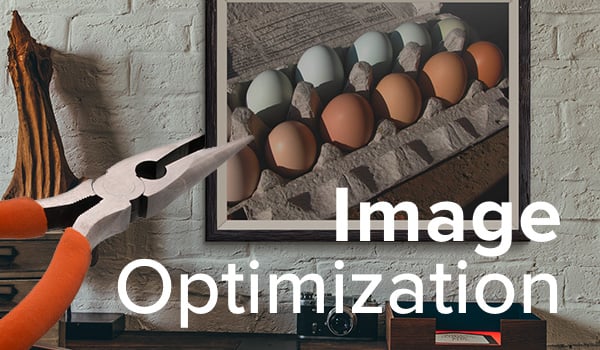
Optimizing You Site’s Imagery for Search Engines

Although the image uploader in our content management system, My JTech, does most of the technical work for you, it is important to understand the importance of SEO image file optimization in the case that you are using a more primitive tool. To help you properly optimize your site’s images, our digital marketing team has put together a few tips and tricks so that you can achieve the best possible search engine ranking.
File name optimization.
Non-standard image file names can cause some issues, such as confusing the web browser and causing it to try loading your image from a non-existent location. Some best-practice naming rules to remember are:
- Use only lower-case letters.
- Instead of spaces, use a dash between words.
- No numbers, underscores or punctuation.
- No characters that are not letters.
Your file names should also be short, comprehendible, and contain at least one keyword. Instead of “FRESH EGGS/YUMMY!!!.jpg,” your file name should be formatted as such: “fresh-eggs.jpg” Creating web-friendly file names means these files are search engine-friendly as well.
File size optimization.
For optimal site performance, the image file you upload should be properly sized and passed through an image file optimizer. We recommend ImageOptim, as it can often produce 80-90% savings. This takes bloat off of your page load, which not only improves user experience but also your ranking, since Google is known for penalizing sites with poor performance.

Title text is a description of the image. Title text is not significant to search engines, and is used as an accessibility tool — when you mouseover an image, a little window should appear that contains the image title text.
Image alt text.
Alt text, however, is recognized by Google for accessibility. To get the most out of your alt text, keep it short — a single sentence will do. Try to organically apply a primary keyword or two, but don’t overstuff, as this becomes unhelpful to users and Google will recognize it as spam.
Image alt text.
Alt text, however, is recognized by Google for accessibility. To get the most out of your alt text, keep it short — a single sentence will do. Try to organically apply a primary keyword or two, but don’t overstuff, as this becomes unhelpful to users and Google will recognize it as spam.
For example, if you run a website promoting your local farm in Wilsall, MT, the descriptive alt text on your image of farm fresh eggs can help give a keyword boost to the page.
Google sitemap.
Finally, you should upload a sitemap to Google search console. A sitemap is an XML document submitted to search engines that allows them to understand the structure of all content on your website — including images. This allows Google to more easily crawl your site and display you in relevant results. Submitting sitemaps is part of the service JTech provides when building or optimizing sites for our clients.
The importance of optimized images.
Any SEO effort to refine your site's content should include image optimization. This will ensure that you are positioned as a relevant result when people search for the products and services you offer — making it easy for potential customers to find you. Image optimization, particularly file names and alt text, serve not just textual search listings, but also Google and Bing's image search. If you’re a JTech customer, our content management system handles a lot of this work for you, requiring a user only to have to title each image – this the image title is automatically used as alt text. In a perfect world, all image managers would have this functionality, but it is good information to understand in the case that you find yourself using a less-sophisticated tool. If you have any questions about uploading images to your site or need help with any content optimization, give us a call!
Finally, you should upload a sitemap to Google search console. A sitemap is an XML document submitted to search engines that allows them to understand the structure of all content on your website — including images. This allows Google to more easily crawl your site and display you in relevant results. Submitting sitemaps is part of the service JTech provides when building or optimizing sites for our clients.
The importance of optimized images.
Any SEO effort to refine your site's content should include image optimization. This will ensure that you are positioned as a relevant result when people search for the products and services you offer — making it easy for potential customers to find you. Image optimization, particularly file names and alt text, serve not just textual search listings, but also Google and Bing's image search. If you’re a JTech customer, our content management system handles a lot of this work for you, requiring a user only to have to title each image – this the image title is automatically used as alt text. In a perfect world, all image managers would have this functionality, but it is good information to understand in the case that you find yourself using a less-sophisticated tool. If you have any questions about uploading images to your site or need help with any content optimization, give us a call!
